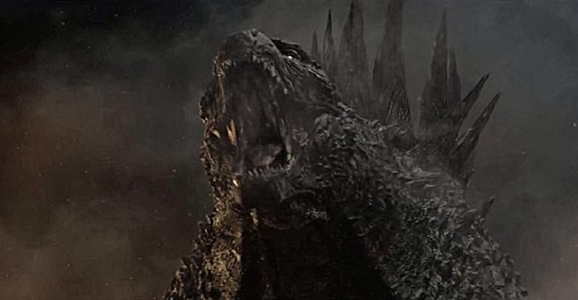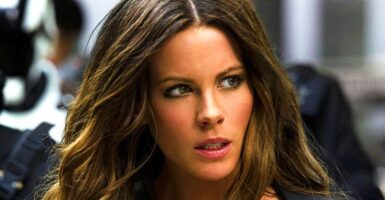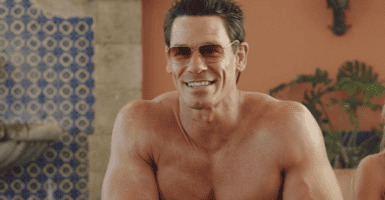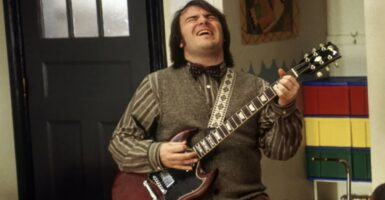Gareth Edwards On Godzilla’s Deaths And Godzilla’s Breath
This article is more than 2 years old
 Godzilla may have been eclipsed at the box office last weekend by X-Men: Days of Future Past, but with director Gareth Edwards contracted for at least one more film, we definitely haven’t see the last of this latest incarnation of everybody’s favorite lumbering atomic beast. But now that most of us have seen Edwards’ Godzilla for ourselves, it’s a chance to explore what went into the making of the colossal flick, and Edwards is dishing all sorts of goodies in an interview with Empire magazine. But if you haven’t seen Godzilla yet…
Godzilla may have been eclipsed at the box office last weekend by X-Men: Days of Future Past, but with director Gareth Edwards contracted for at least one more film, we definitely haven’t see the last of this latest incarnation of everybody’s favorite lumbering atomic beast. But now that most of us have seen Edwards’ Godzilla for ourselves, it’s a chance to explore what went into the making of the colossal flick, and Edwards is dishing all sorts of goodies in an interview with Empire magazine. But if you haven’t seen Godzilla yet…
Warning: monster-sized spoilers below!
One of Godzilla‘s biggest surprises was just how little it used one of its biggest stars. For many of us, Godzilla is the first role we’ve seen actor Bryan Cranston in since the end of his brilliant turn as Walter White on AMC’s crime drama Breaking Bad. It’s safe to say that is one hell of a hard act to follow, so we were expecting his Godzilla role to be very unlike Walter, but we didn’t expect it to be so short. As in, “dead by the end of the first act.” As scientist Joe Brody, Cranston spends his brief time on screen determined to prove that the death of his wife during a mysterious calamity at the Japanese nuclear plant where they were working at was no accident, and that the people in charge know far more than they’re letting on. And he’s proven right, in front of his doubting son Ford (Aaron Taylor-Johnson)…just in time to die during the escape rampage of one of the film’s ferocious “M.U.T.O.” creatures.
Edwards said Brody’s number was up long before Cranston was cast in the role, and was necessary because at that point the character has pretty much served his purpose. Edwards tells Empire:
I’ll be honest with you: we tried versions in the screenplay where he survived. And in every one we did that with, there was nothing else that character could do without being silly. If he sticks with Ford, it becomes Indiana Jones and the Last Crusade, and the tone of the movie becomes fun, but not the tone we were trying to do. And if he sticks with the military guys, he’s like a fifth wheel. His job was done in the storyline there.
Over the course of the film we watch Godzilla get clobbered by the two M.U.T.O. creatures, but he saves one of his most iconic attacks for the film’s climax. Everybody loves Godzilla’s atomic breath, but it’s the sort of thing that really needs to be used in moderation, especially when you’re going for a semi-realistic tone (well, as realistic as a movie about giant monsters can be). Sure, we’re not technically given any in-story reason why Godzilla couldn’t just bust out the blue flames during the first M.U.T.O. encounter, but the narrative reason is because, after waiting most of the film, holy crap is it satisfying when Godzilla finally does cut loose. The way Edwards stages the first atomic breath moment, the visual build-up to it, made for one of the most satisfying moments I’ve had in a movie in ages. And when he brings it out for the second time, it’s for a coup de grace worthy of the Mortal Kombat franchise.
But Edward didn’t arrive at the final vision of the atomic breath right away, either visually or narratively. He says:
At one point we dabbled with lightning, to make it a little bit more to do with nature, in terms of god-like destruction. But it was considered not enough like classic Godzilla. And that moment, actually, working out how we were going to kill the M.U.T.O., we made a last-minute decision: ‘What if he just pulls apart [the M.U.T.O.’s jaws]?’ We were going to just break the jaws, and it felt like that was too much like King Kong. ‘So what if he just vomits blue breath? Nearly a kiss?’
We thought we weren’t going to get away with it. ‘This is absurd,’ we thought. And then we sat and did a test screening and it was everyone’s favourite moment.
For a film riding on the legacy of a beloved character six decades old, it shouldn’t surprise anyone that there were plenty of Easter eggs hiding in the film. Classic Godzilla critter Mothra gets several nods, with the name actually written on the side of young Ford’s terrarium in the movie’s opening sequence, and with multiple cocoon/moth/butterfly references seen in a Japanese classroom. One particularly cheeky addition is the poster seen briefly in Ford’s room. Edwards explains:
On the poster, in Japanese — because obviously we all know Japanese — the title of that film is ‘Let Them Fight.’ If you look at the images, they are M.U.T.O.s and a nuclear reactor and the Golden Gate Bridge. The movie is represented on that poster.
Finally, Edwards explains how two big names contributed to his vision of Godzilla: motion-capture maestro Andy Serkis and writer Frank Darabont (The Mist, The Walking Dead). Serkis was brought in late in the day to “give it some soul” in crucial moments such as when a fallen Godzilla makes eye contact with Ford in the aftermath of his long battle. Darabont provided a similar service for the script. Edwards recalls:
He came in and gave a pass of the screenplay about two or three months before we started filming. A lot of his work remains in the film, but a big part of it is when the doors close on Juliette Binoche — this whole idea that there’s a gateway or a check point they have to get through, and that it would close, and you would see her die, and we’d have that very emotional moment. That was his biggest contribution. It’s the emotional peak of the film, potentially. That’s why he’s Frank Darabont.
I don’t know about you, but I’m getting a little choked up by all of this. Let’s watch some crazy Japanese Pepsi ads with giant monsters to take our minds off it.












